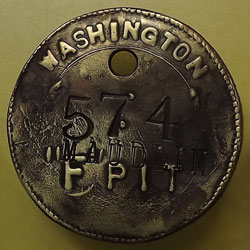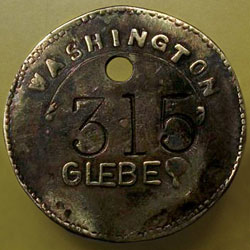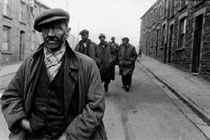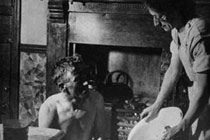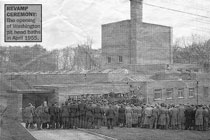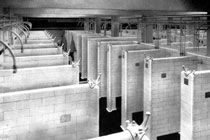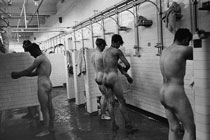Washington County Durham
HOME WHAT'S WHERE MINING COLLECTION 3
Memories of Mining
Pithead Baths
Pithead Baths
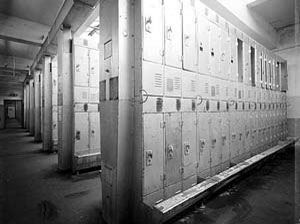
← Home / Canteen Clean Lockers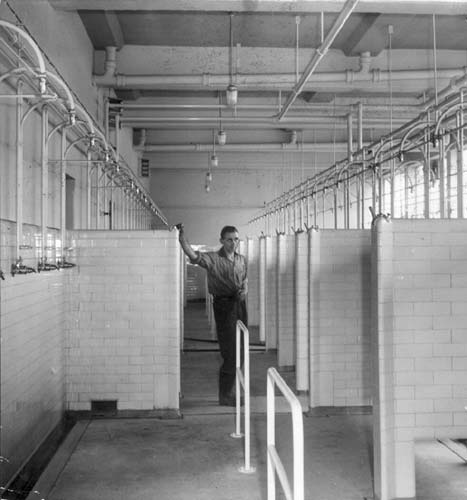
Baths Superintendent / Showers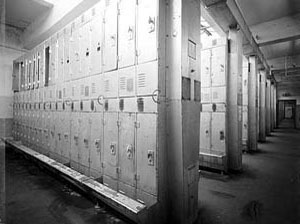
Dirty Lockers Lamp Cabin →
Before and After a Miner's Shift
1. Each miner was allocated two secure lockers (same number; same key), one for home (clean) clothes and one for pit (dirty) clothes.
2. You began your preparation for going underground by locking your home clothes in your clean locker. Wearing only flip-flops, and carrying your soap dish, flannel & towel, you walked (unashamedly naked) to your dirty locker at the other end of the baths.
3. You then put on your pit clothes, helmet & boots, locked your flip-flops, soap dish & towel in your dirty locker, and headed to the Lamp Cabin.
4. At the Lamp Cabin you collected your personal equipment - a cap lamp, two identity tokens (marked with your unique works number) and a self-rescuer - designed to give one hour's protection from carbon monoxide (CO). Overmen & Deputies also collected a Flame Safety Lamp - used to detect the presence of the highly explosive gas methane (CH4). You then went to the heapstead, to 'ride' in the pit cage.
5. You handed your non-brass (rather cheap looking) token to the Banksman immediately before stepping into the cage.
This recorded individual miners as being underground.
6. You would then work your u/g shift - 7¼ hrs, surface to surface - making sure that you were at the Shaft Bottom for your 'riding' time.
• • ◊ • •
7. On your return to the surface, the second (nicely finished brass) token was given to the Banksman when you stepped out of the cage. This recorded individual miners as no longer being underground. As well as being used for timekeeping and logging miners u/g, the brass token also allowed early identification of casualties in the event of a serious incident.
8. In less enlightened times, many miners went straight to their personal, ingeniously concealed, weather protected, hidey-holes. These contained tabs & matches. Smoking underground is a criminal offence and many miners couldn't wait until they'd been through the baths - lighting-up was their top priority!
9. After returning their cap lamps and self-rescuers to the Lamp Cabin, miners would return their pit clothes to their dirty lockers, collect their flip-flops, soap dish & towel and head, stark naked once again, into the showers. Most showers were housed in individual cubicles, others were fixed along open walls. Miners tended to have a favourite shower and used it every day.
10. Problems washing your sweaty back? Ask the guy in the next shower, hand him your sponge/flannel, and he'd wash your back for you.
You would then return the compliment.
11. A quick towel down after your shower then it was off to your clean locker to get dressed and lock up your flip-flops, soap dish & towel.
12. Both sets of lockers had warm air ducts in them so your pit clothes and towel would be dry in time for your next shift.
13. Scores of men (at some pits, well over a hundred) showered and changed together at the end of main shifts. No problems at all.
14. Being shy wasn't an option!
• • ◊ • •
The Colliery Manager had his own washing facilities and his senior staff (Undermanagers, Electrical & Mechanical Engineers, and the Colliery Surveyor) all shared a private shower/locker room. They were not members of the NUM or the Overmen & Deputies union NACODS. They belonged to the British Association of Colliery Management, BACM.
[Pit Terms: see What's Where; Collieries; Pitmatic.]
